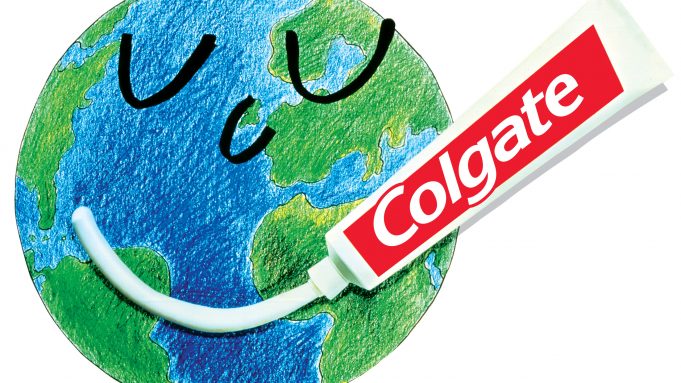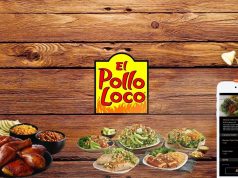This report provides the last five years revenues and revenue growth of Colgate Palmolive Co (CL) from 2012 to 2016. Colgate Palmolive generated a total of $15.2 billion revenues during 2016. Colgate Palmolive reported a revenue growth of -5.2% year-over-year during 2016. The revenues and the revenue growth correspond to the fiscal year ending in December.
COLGATE PALMOLIVE REVENUES FROM 2012 TO 2016
Here are the revenues and the revenue growth details of Colgate Palmolive during the last five years:
- Colgate Palmolive generated a total of $17.1 billion revenues during 2012. Colgate Palmolive reported a revenue growth of 2.1% year-over-year during 2012.
- Colgate Palmolive generated a total of $17.4 billion revenues during 2013. Colgate Palmolive reported a revenue growth of 2% year-over-year during 2013.
- Colgate Palmolive generated a total of $17.3 billion revenues during 2014. Colgate Palmolive reported a revenue growth of -0.8% year-over-year during 2014.
- Colgate Palmolive generated a total of $16 billion revenues during 2015. Colgate Palmolive reported a revenue growth of -7.2% year-over-year during 2015.
- Colgate Palmolive generated a total of $15.2 billion revenues during 2016. Colgate Palmolive reported a revenue growth of -5.2% year-over-year during 2016.
WHY ANALYZE REVENUE GROWTH?
Revenue growth is the most commonly analyzed financial metric. Revenue Growth is the percent increase (or decrease) of a company’s revenue between two time periods. It is computed by using the following formula: ((revenues during the time period two – revenues during the time period one) / revenues during the time period one)*100. If the time periods are two consecutive years, then the revenue growth is referred to as the annual revenue growth year-over-year. If the time periods are two consecutive quarters, then the revenue growth is referred to as the quarterly revenue growth quarter-over-quarter. If the time periods refer to the same quarter in the two consecutive years, then the revenue growth is referred to as quarterly revenue growth year-over-year. In case the time periods are two non-consecutive years, then the revenue CAGR (Commutative Annual Growth Rate) is computed.
Revenue growth analysis is important for a number of reasons. First, it helps in understanding how a business is performing. If the revenue growth rates are positive, it means the business is performing well and the revenues are increasing. If the revenue growth rates are negative, it means the revenues are declining and the company needs to take measures to increase them. If they don’t, the company will continue to shrink. Second, a company’s historical revenue growth analysis along with the market size and market share analysis helps in forecasting the future revenues of a company. Third, a comparison of a company’s growth rates with its competitors helps in determining who is winning more business. A revenue growth higher than the industry average translates into increasing market share. Companies with very high revenue growth rates have the potential to be the industry disruptors.
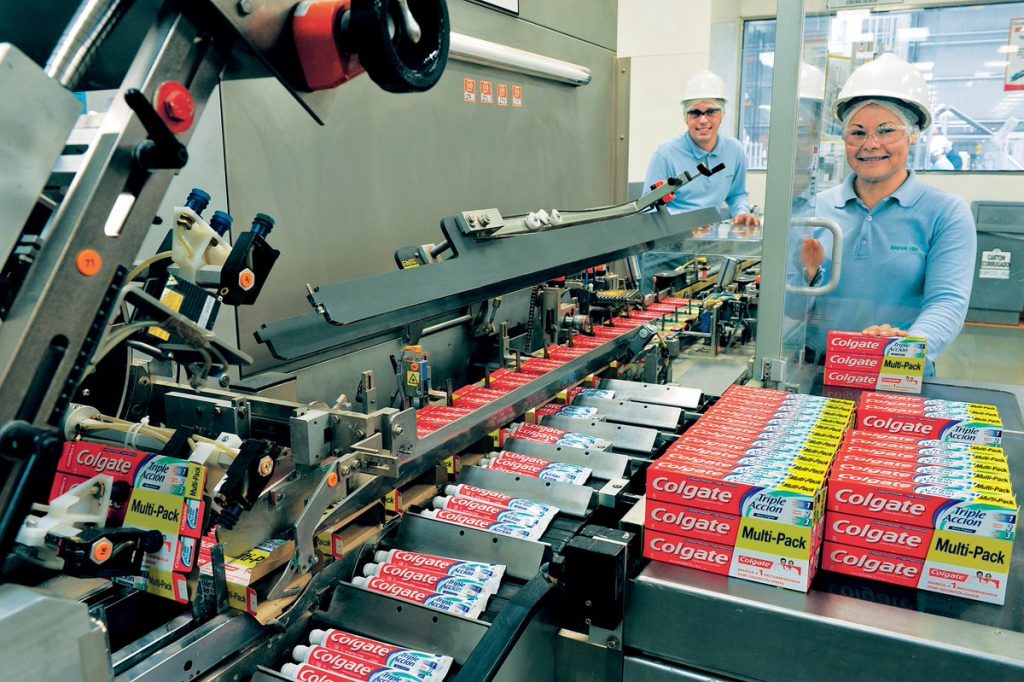
COLGATE PALMOLIVE RANKING
With $15.2 billion revenues, Colgate Palmolive ranked number 181 in the R&P; Research list of top-3000 public companies in the US by revenues during 2016. Each one of the top-3000 companies generated more than $50 million of annual revenues during 2016.
The top-20 companies in the US by revenues during 2016 were:
- Walmart ($482.1 billion)
- ExxonMobil ($226.1 billion)
- Berkshire Hathaway ($223.6 billion)
- Apple ($215.6 billion)
- McKesson ($190.9 billion)
- UnitedHealth Group ($184.8 billion)
- CVS Health ($177.5 billion)
- General Motors ($166.4 billion)
- AT&T; ($163.8 billion)
- Ford Motor ($151.8 billion)
- AmerisourceBergen ($146.8 billion)
- Amazon ($136 billion)
- Verizon ($126 billion)
- General Electric ($123.7 billion)
- Cardinal Health ($121.5 billion)
- Costco ($118.7 billion)
- Walgreens Boots Alliance ($117.4 billion)
- Chevron ($114.5 billion)
- Kroger ($109.8 billion)
- Express Scripts Holding ($100.3 billion)
For the purpose of performance benchmarking of a company with a sector or industry average, R&P; Research associates every company with one sector and one industry. An industry consists of companies with related/similar business models. A sector comprises of a group of related/similar industries. For example, Life Sciences sector is comprised of following industries: Pharmaceuticals; Medical Devices; Biotechnology; Diagnostics & Scientific Instruments.
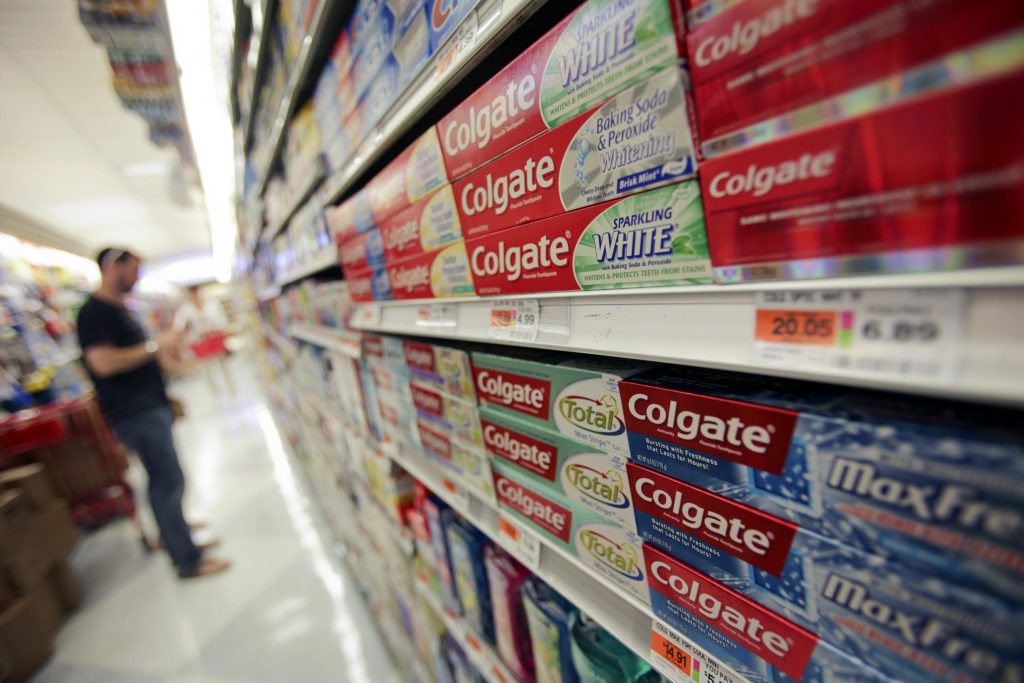
Colgate Palmolive is associated with Consumer Goods Sector and Personal Goods Industry.
With $15.2 billion revenues, Colgate Palmolive ranked number 19 of all the companies in the US Consumer Goods sector. There were a total of 207 public companies in the US Consumer Goods sector that had revenues greater than $50 million during 2016.
The top-10 companies in the US Consumer Goods sector by revenues during 2016 were:
- Philip Morris International ($75 billion)
- P&G; ($65.3 billion)
- PepsiCo ($62.8 billion)
- Archer Daniels Midland ($62.3 billion)
- Sysco ($50.4 billion)
- Bunge ($42.7 billion)
- Coca-Cola ($41.9 billion)
- Tyson Foods ($36.9 billion)
- Nike ($32.4 billion)
- Kraft Heinz ($26.5 billion)
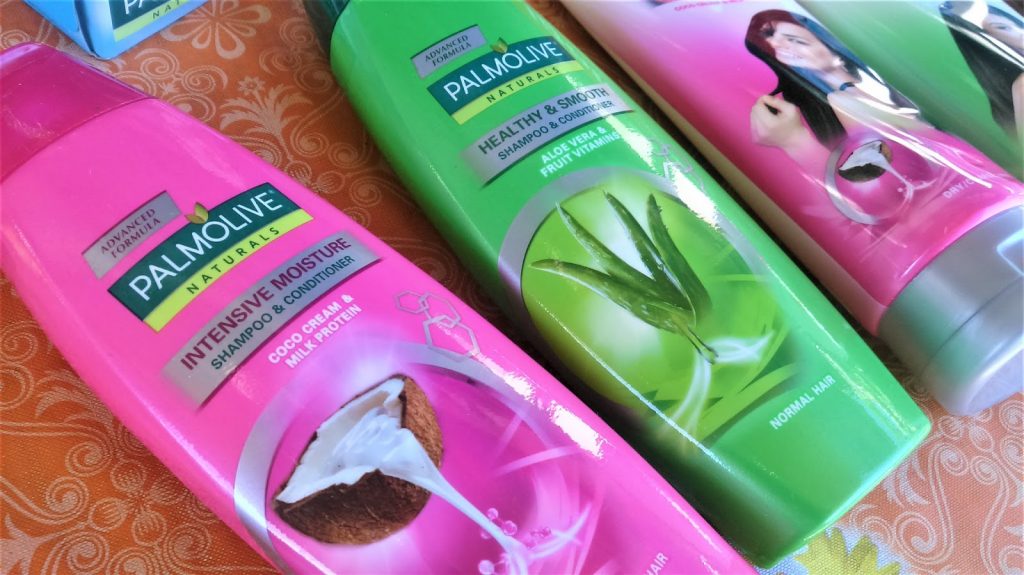
Consumer Goods sector is comprised of the following industries: Beverages; Personal Goods; Food Products; Diversified Food; Household Goods & Home Construction; Food Distribution; Toys and Games. The definitions for each of the industries is as follows:
- Beverages industry consists of: Brewing Companies – manufacturers of cider or malt products and Soft Drinks Companies – manufacturers, bottlers and distributors of nonalc*holic beverages, such as soda, fruit juices, tea, coffee and bottled water.
- Personal Goods industry includes: Clothing & Accessories Companies – manufacturers and distributors of all types of clothing, jewellery, watches or textiles, sportswear, sunglasses, eyeglass frames, leather clothing and goods, and processors of hides and skins; Footwear Companies – manufacturers and distributors of shoes, boots, sandals, sneakers and other types of footwear; and Consumer Packaged Goods Companies – makers and distributors of cosmetics, toiletries and personal-care and hygiene products, including deodorants, soaps, toothpaste, perfumes, diapers, shampoos, razors and feminine hygiene products.
- Food Products industry includes: Farming & Fishing companies – companies that grow crops or raise livestock; Food Products Companies – food producers, including meatpacking, snacks, fruits, vegetables, dairy products and frozen seafood. It also includes producers of pet food and manufacturers of dietary supplements, vitamins and related items.
- Diversified Food industry includes companies that offer a diverse portfolio of food products across agricultural, animal and dairy product categories.
- Household Goods & Home Construction industry includes companies that offer: Durable Household Products – Manufacturers and distributors of domestic appliances, lighting, hand tools and power tools, hardware, cutlery, tableware, garden equipment, luggage, towels and linens; Nondurable Household Products – Producers and distributors of pens, paper goods, batteries, light bulbs, tissues, toilet paper and cleaning products such as soaps and polishes; Furnishings – Manufacturers and distributors of furniture, including chairs, tables, desks, carpeting, wallpaper and office furniture; Home Construction – constructors of residential homes, including manufacturers of mobile and prefabricated homes intended for use in one place.
- Food Distribution industry includes companies that distribute food, beverage and consumer goods to restaurants, healthcare, educational facilities, lodging establishments; equipment and supplies for the foodservice and hospitality industries.
- Toys and Games industry consists of manufacturers and distributors of toys and video/computer games, including such toys and games as playing cards, board games, stuffed animals and dolls.
With $15.2 billion revenues, Colgate Palmolive ranked number 4 of all the companies in the US Personal Goods industry. There were a total of 52 public companies in the US Personal Goods industry that had revenues greater than $50 million during 2016.
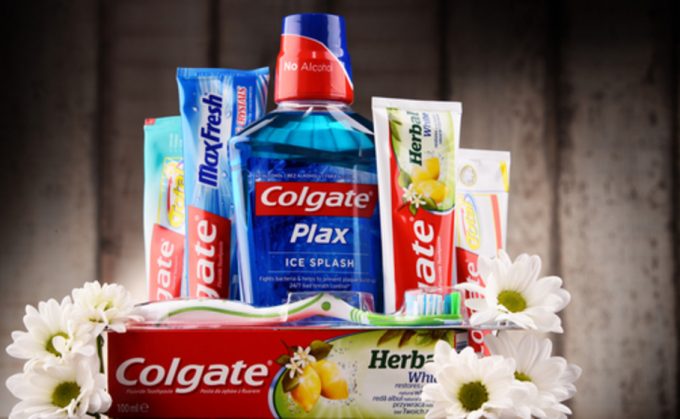
The top-10 companies in the US Personal Goods industry by revenues during 2016 were:
- P&G; ($65.3 billion)
- Nike ($32.4 billion)
- Kimberly Clark ($18.2 billion)
- Colgate Palmolive ($15.2 billion)
- VF ($12 billion)
- Estee Lauder ($11.3 billion)
- PVH ($8 billion)
- Foot Locker ($7.4 billion)
- Ralph Lauren ($7.4 billion)
- Signet Jewelers ($6.6 billion)
COMPANIES SEGMENTATION
To identify and analyze high/low growth or most/least profitable similar-size companies in different sectors or industries, R&P; research classifies all companies into different segments based upon their revenues, revenue growth, and net profit margins.
Based upon their annual revenues, the companies are classified into one of the following four segments:
- Mega companies, having revenues greater than $50 billion.
- Very Large companies, having revenues between $10 billion and $50 billion.
- Large companies, having revenues between $1 billion and $10 billion.
- Mid-size companies, having revenues between $50 million and $1 billion.
With $15.2 billion revenues, Colgate Palmolive was in the Very Large companies revenue segment during 2016. There were a total of 239 companies in the Very Large companies revenue segment during 2016.
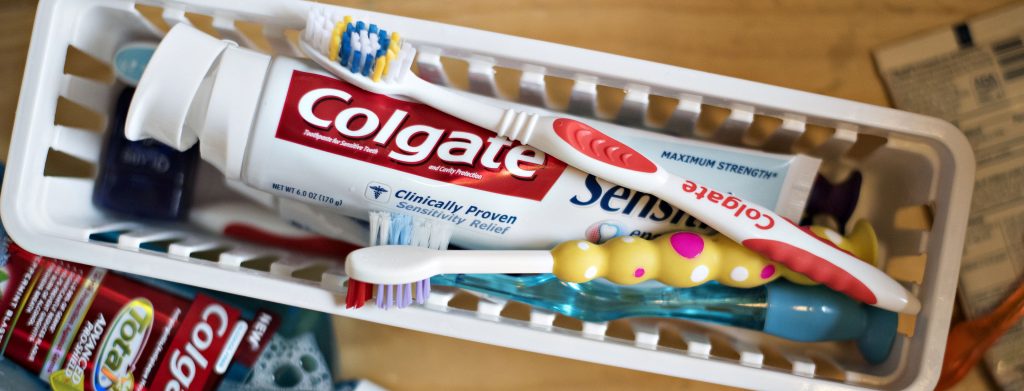
Based upon their annual revenue growth, the companies are classified into one of the following eight segments:
- Very High positive growth companies, having annual revenue growth greater than 50%.
- High positive growth companies, having annual revenue growth between 20% and 50%.
- Medium positive growth companies, having annual revenue growth between 5% and 20%.
- Low positive growth companies, having annual revenue growth between 0% and 5%.
- Low negative growth companies, having annual revenue growth between -5% and 0%.
- Medium negative growth companies, having annual revenue growth between -20% and -5%.
- High negative growth companies, having annual revenue growth between -50% and -20%.
- Very High negative growth companies, having annual revenue growth less than -50%.
With -5.2% revenue growth year-over-year, Colgate Palmolive was in the Medium negative revenue growth segment during 2016. There were a total of 448 companies in the Medium negative revenue growth segment during 2016. Of the US top-3000 companies, 1985 (nearly two-third of the total) had positive revenue growth and 1015 (nearly one-third of the total) had negative revenue growth during 2016.
Based upon their annual net profit margin, the companies are classified into one of the following eight segments:
- Very High positive margin companies, having net profit margin greater than 50%.
- High positive margin companies, having net profit margin between 20% and 50%.
- Medium positive margin companies, having net profit margin between 5% and 20%.
- Low positive margin companies, having net profit margin between 0% and 5%.
- Low negative margin companies, having net profit margin between -5% and 0%.
- Medium negative margin companies, having net profit margin between -20% and -5%.
- High negative margin companies, having net profit margin between -50% and -20%.
- Very High negative margin companies, having net profit margin less than -50%.
With a net margin of 16.1%, Colgate Palmolive was in the Medium positive net profit margin segment during 2016. There were a total of 1086 companies in the Medium positive net profit margin segment during 2016. Of the US top-3000 companies, 2244 (nearly three-fourth of the total) had positive net profit margin and 756 (nearly one-fourth of the total) had negative net profit margin during 2016.
COMPANY BUSINESS SUMMARY

Colgate-Palmolive Company, together with its subsidiaries, manufactures and sells consumer products worldwide. It operates through two segments, Oral, Personal and Home Care; and Pet Nutrition. The company offers oral care products, including toothpastes, toothbrushes, and mouthwashes, as well as pharmaceutical products for dentists and other oral health professionals; personal care products comprising bar and liquid hand soaps, shower gels, shampoos, conditioners, and deodorants and antiperspirants; and home care products, such as laundry and dishwashing detergents, fabric conditioners, household cleaners, bleaches, and other related products. It also provides pet nutrition products for everyday nutritional needs, a range of therapeutic products to manage disease conditions, and various products with natural ingredients. The company’s principal global and regional trademarks include Colgate, Palmolive, Speed Stick, Lady Speed Stick, Softsoap, Irish Spring, Protex, Sorriso, Kolynos, elmex, Tom’s of Maine, Sanex, Ajax, Axion, Fabuloso, Soupline, and Suavitel, as well as Hill’s Science Diet, Hill’s Prescription Diet, and Hill’s Ideal Balance. It markets and sells its pet nutrition products for dogs and cats through pet supply retailers and veterinarians. Colgate-Palmolive Company was founded in 1806 and is headquartered in New York, New York.
INDUSTRY PEERS AND COMPETITORS OF COLGATE PALMOLIVE
P&G (PG) Business Analysis – Analyze Historical Performance, Strategic Priorities, And…
Procter & Gamble Co with $65 billion revenues in the year 2016 was the number 1 Personal Goods company. Read this report to know the top competitors of P&G; and identify growth and cost optimization opportunities of P&G;
Nike (NKE) Business Analysis – Analyze Historical Performance, Strategic Priorities, And…
Nike Inc with $32 billion revenues in the year 2016 was the number 2 Personal Goods company. Read this report to know the top competitors of Nike and identify growth and cost optimization opportunities of Nike
Kimberly Clark (KMB) Business Analysis – Analyze Historical Performance, Strategic Priorities,…
Kimberly Clark Corp with $18 billion revenues in the year 2016 was the number 3 Personal Goods company. Read this report to know the top competitors of Kimberly Clark and identify growth and cost optimization opportunities of Kimberly Clark
VF (VFC) Business Analysis – Analyze Historical Performance, Strategic Priorities, And…
V F Corp with $12 billion revenues in the year 2016 was the number 5 Personal Goods company. Read this report to know the top competitors of VF and identify growth and cost optimization opportunities of VF
Estee Lauder (EL) Business Analysis – Analyze Historical Performance, Strategic Priorities,…
Estee Lauder Companies Inc with $11 billion revenues in the year 2016 was the number 6 Personal Goods company. Read this report to know the top competitors of Estee Lauder and identify growth and cost optimization opportunities of Estee Lauder
PVH (PVH) Business Analysis – Analyze Historical Performance, Strategic Priorities, And…
PVH Corp. with $8 billion revenues in the year 2016 was the number 7 Personal Goods company. Read this report to know the top competitors of PVH and identify growth and cost optimization opportunities of PVH
REVENUES ANALYSIS
Colgate Palmolive (CL) Revenues And Revenue Growth From 2012 To 2016
This report provides the last five years revenues and revenue growth of Colgate Palmolive Co (CL) from 2012 to 2016. Colgate Palmolive generated a total of $15.2 billion revenues during 2016. Colgate Palmolive reported a revenue growth of -5.2% year-over-year during 2016. The revenues and the revenue growth correspond to the fiscal year ending in December.
Colgate Palmolive (CL) Revenues And Revenue Growth From 2002 To 2016
This report provides the last fifteen years revenues and revenue growth of Colgate Palmolive Co (CL) from 2002 to 2016. Colgate Palmolive generated a total of $15.2 billion revenues during 2016. Colgate Palmolive reported a revenue growth of -5.2% year-over-year during 2016. The revenues and the revenue growth correspond to the fiscal year ending in December.
Colgate Palmolive (CL) Revenue Growth Comparison With Industry Growth From 2012…
This report provides a comparison of Colgate Palmolive Co (CL) revenue growth with Personal Goods industry growth during the last five years from 2012 to 2016. Colgate Palmolive reported a revenue growth of -5.2% year-over-year during 2016. The Personal Goods industry growth was -0.4% year-over-year during 2016. Colgate Palmolive growth was slower than the industry during 2016.
PROFIT ANALYSIS
Colgate Palmolive (CL) Net Profit And Net Margin From 2012 To…
This report provides the last five years net profit and net margin of Colgate Palmolive Co (CL) from 2012 to 2016. Colgate Palmolive reported a total net income of $2.4 billion during 2016. Colgate Palmolive generated a total of $15.2 billion revenues during 2016. Colgate Palmolive net profit margin was 16.1% during 2016. The net profit and the net profit margin correspond to the fiscal year ending in December.
Colgate Palmolive (CL) Net Profit And Net Margin From 2002 To…
This report provides the last fifteen years net profit and net margin of Colgate Palmolive Co (CL) from 2002 to 2016. Colgate Palmolive reported a total net income of $2.4 billion during 2016. Colgate Palmolive generated a total of $15.2 billion revenues during 2016. Colgate Palmolive net profit margin was 16.1% during 2016. The net profit and the net profit margin correspond to the fiscal year ending in December.
Colgate Palmolive (CL) Net Profit Margin Comparison With Industry From 2012…
This report provides a comparison of Colgate Palmolive Co (CL) net profit margin with Personal Goods industry net profit margin during the last five years from 2012 to 2016. Colgate Palmolive reported a net profit margin of 16.1% during 2016. The Personal Goods industry net profit margin was 10.5% during 2016. Colgate Palmolive was more profitable than the industry during 2016.
COST & EXPENSES ANALYSIS
Colgate Palmolive (CL) Cost of Sales (COGS) Analysis From 2012 To…
This report provides the last five years cost of sales (COGS) analysis of Colgate Palmolive Co (CL) from 2012 to 2016. Colgate Palmolive spent a total of $6.1 billion on COGS during 2016. Colgate Palmolive generated a total of $15.2 billion revenues during 2016. As a percentage of revenues, Colgate Palmolive spent 40% of its total revenues on COGS during 2016. The cost of sales (COGS) numbers are for the fiscal year ending in December.
Colgate Palmolive (CL) Research & Development (R&D) Spending Analysis 2016
R&D; spending analysis for Colgate Palmolive is not available because either the company does not provide the data or we don’t have it.
Colgate Palmolive (CL) Sales, Marketing, General & Administrative (SG&A) Spending Analysis…
This report provides the last five years sales, marketing, general & administrative (SG&A;) expenses of Colgate Palmolive Co (CL) from 2012 to 2016. Colgate Palmolive spent a total of $5.2 billion on sales, marketing, general, and administrative (SG&A;) activities during 2016. Colgate Palmolive generated a total of $15.2 billion revenues during 2016. As a percentage of revenues, Colgate Palmolive spent 34.5% of its total revenues on SG&A; activities during 2016. The SG&A; spending numbers are for the fiscal year ending in December.
WORKING CAPITAL ANALYSIS
Colgate Palmolive (CL) Inventory Spending Analysis From 2012 To 2016
This report provides the last five years inventory spending analysis of Colgate Palmolive Co (CL) from 2012 to 2016. Colgate Palmolive invested a total of $1.2 billion on inventories during 2016. Colgate Palmolive generated a total of $15.2 billion revenues during 2016. As a percentage of revenues, Colgate Palmolive invested 7.7% of its total revenues on inventories during 2016. The inventory numbers are for the fiscal year ending in December.
Colgate Palmolive (CL) Accounts Receivable (A/R) Analysis From 2012 To 2016
This report provides the last five years Accounts Receivable (A/R) analysis of Colgate Palmolive Co (CL) from 2012 to 2016. Colgate Palmolive invested a total of $1.4 billion on accounts receivable during 2016. Colgate Palmolive generated a total of $15.2 billion revenues during 2016. As a percentage of revenues, Colgate Palmolive invested 9.3% of its total revenues on accounts receivable during 2016. The accounts receivable numbers are for the fiscal year ending in December.
Colgate Palmolive (CL) Accounts Payable (A/P) Analysis From 2012 To 2016
This report provides the last five years Accounts Payable (A/P) analysis of Colgate Palmolive Co (CL) from 2012 to 2016. Colgate Palmolive invested a total of $1.1 billion on accounts payable during 2016. Colgate Palmolive generated a total of $15.2 billion revenues during 2016. As a percentage of revenues, Colgate Palmolive invested 7.4% of its total revenues on accounts payable activities during 2016. The accounts payable numbers are for the fiscal year ending in December.
ASSET MANAGEMENT ANALYSIS
Colgate Palmolive (CL) Property, Plant & Equipment (PP&E) Investment Analysis From…
This report provides the last five years property, plant & equipment (PP&E;) investment analysis of Colgate Palmolive Co (CL) from 2012 to 2016. Colgate Palmolive invested a total of $3.8 billion on property, plant & equipment (PP&E;) activities during 2016. Colgate Palmolive generated a total of $15.2 billion revenues during 2016. As a percentage of revenues, Colgate Palmolive invested 25.3% of its total revenues on PP&E; activities during 2016. The PP&E; investment numbers are for the fiscal year ending in December.
Colgate Palmolive (CL) Intangible Assets Analysis From 2012 To 2016
This report provides the last five years Intangible assets analysis of Colgate Palmolive Co (CL) from 2012 to 2016. Colgate Palmolive invested a total of $3.4 billion on Intangible assets during 2016. Colgate Palmolive generated a total of $15.2 billion revenues during 2016. As a percentage of revenues, Colgate Palmolive invested 22.5% of its total revenues on intangible assets during 2016. The Intangible asset numbers are for the fiscal year ending in December.

